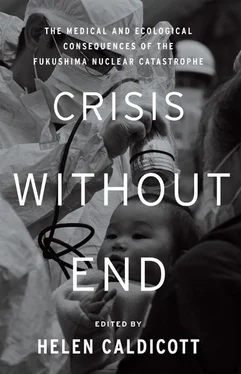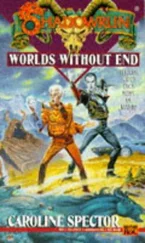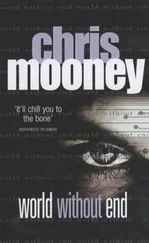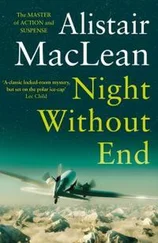The network was set up without considering the possibility of a large-scale spread of radioactive materials. At the time of the accident there were six primary emergency medical hospitals in Fukushima, of which three were located within a ten-kilometer radius of the power plant. These hospitals became unusable as staff and patients were forced to evacuate. The staff and patients at three other regular hospitals within the zone were also forced to evacuate, and during the course of the evacuation sixty patients died. The diet investigation found that more than 50 percent of the fifty-nine primary hospitals nationwide are located within a twenty-kilometer radius of nuclear power plants, which means they are within the evacuation zone. What is more, the maximum number of patients who can be hospitalized in a primary or secondary hospital is just one or two, while a tertiary hospital can take no more than ten critically ill patients.
Soon after the disaster, Fukushima Prefecture launched a health management survey to investigate the long-term effects of low doses of radiation, some of which has been made public. Thyroid ultrasound examinations were performed on children in Fukushima aged eighteen or younger. In 2011, approximately 38,000 children were examined, and of those children, 186 were found to have a nodule larger than 5 millimeters or a cyst larger than 20 millimeters. Three children were diagnosed with thyroid cancer and seven children were at risk of thyroid cancer. According to Fukushima Medical University’s Shunichi Yamashita, who was responsible for the Radiation Medical Science Center’s Fukushima Health Management Survey, thyroid cancer is usually found only in one child out of a million, and so it appears that the incidence of thyroid cancer has increased since the accident.
The endless debate on low-dose radiation risks is not a scientific issue but a political, economic, and social issue. Scientists must convey scientific truth; they should not be mouthpieces for governments or power companies. Four reactors at Fukushima are broken and nobody knows how or when they can be isolated from the environment. Since Japan is indeed a land of earthquakes, it is a race against time to shut them down completely. The Japanese government and power companies must make it their priority to stop any further damage and halt the ongoing spread of radioactive substances. It is their responsibility because they promoted nuclear power in the first place. It is also the responsibility of every person in Japan to make sure that all reactors in Japan are shut down. Since September 2013, none of the nuclear power plants has been operating, and with no electricity shortage to speak of, there is no reason that any of them should be restarted.
5
The Contamination of Japan with Radioactive Cesium
Steven Starr
Nuclear technology is the equivalent of acquiring on earth the technology of the heavens…. The deployment here on earth of nuclear reactions, a phenomenon occurring naturally only in heavenly bodies and completely unknown to the natural world here on the earth’s surface, is… a matter of deep significance. For all forms of life, radiation is a threat against which they possess no defense; it is an alien intruder disrupting the principles of life on earth. Our world on the surface of this planet, including life, is composed most basically of chemicals… and its cycles take place as processes of combination and dissolution of chemical substances…. Nuclear civilization always harbors in its womb a moment of destruction, like a ticking time bomb. The danger it presents… is of a kind completely unlike those we have faced before. And now isn’t it the case that the ticking of its timer is growing louder and louder in our ears?
—Takagi Jinzaburō, 1986
The destruction of the Fukushima Daiichi nuclear power plant released a huge quantity of highly radioactive isotopes that grossly contaminated the Japanese mainland. Most of these radionuclides had short half-lives, which meant they would self-destruct and disappear in a matter of days or months. But for many of the unfortunate people who inhaled and absorbed these short-lived radioactive poisons, there will be major health consequences. [1] For example, the Norwegian Institute for Air Research estimates that the destroyed nuclear reactors at Fukushima released 2.5 times more radioactive xenon-133 gas than the destruction of the nuclear reactor at Chornobyl. Xenon-133 has a half-life of about five days, so in two months most of it had disappeared from the environment. But the winds from Fukushima carried a giant cloud of xenon-133 directly over the Tokyo metropolitan area, where (according to the Japan Chemical Analysis Center) it averaged 1,300 atomic disintegrations per second in every cubic meter of air from March 14 through March 22, 2011. The Japanese government chose not to warn people in Tokyo to take any precautions.
The disaster also released radionuclides that will not rapidly disappear. These will remain in contaminated Japanese ecosystems, where they will negatively affect the complex life-forms exposed to them. Chief among them is cesium-137, [2] This is not to diminish the importance of other long-lived radionuclides released by catastrophic nuclear accidents, such as strontium-90 and plutonium, which can affect living things in equally bad or even worse ways. But there appears to be proportionally much less of these radionuclides released than cesium-137 in reactor accidents, so the emphasis in this chapter is on radioactive cesium.
which has taken on special significance because it is the most abundant of the long-lived radionuclides that have persisted in the environment following destruction of the nuclear power plant at Chornobyl.
Cesium-137 has been widely distributed as fallout following catastrophic accidents at nuclear power plants because it is a common fission product that builds up inside the used fuel rods of nuclear reactors, and because it becomes a gas at relatively low temperatures. Any accident that causes the fuel rods to heat to the point of rupture or ignition will cause a large release of highly radioactive cesium gas. [3] Cesium becomes a gas at 1,240 degrees Fahrenheit (at one atmosphere of pressure), whereas fuel rods heat to the point of rupture at about 1,500 degrees Fahrenheit and ignite at 3,300 degrees Fahrenheit. The buildup of gas pressure inside the rod causes it to rupture (the zirconium cladding bursts). The zirconium cladding on spent fuel rods will react exothermically when exposed to air and heated to around 1,800 degrees Fahrenheit, creating a catastrophic fire with consequences potentially worse than a reactor meltdown. (B. Alvarez, “What About the Spent Fuel?,” Bulletin of the Atomic Scientists , January–February 2002, 45–47.)
Burning fuel rods also release highly radioactive aerosols and “hot particles” into the atmosphere. They are then dispersed by the winds.
Cesium-137 becomes most concentrated in terrestrial ecosystems where it “falls out” or is rained out of the sky, and in this fashion makes its way into waters and soils. [4] This fallout is most concentrated by rainfall that washes it from the sky, which tends to concentrate it in an irregular fashion, accounting for its patchy deposition.
Cesium easily moves and spreads in the biosphere, because its most common chemical compounds are highly soluble in water. Consequently, cesium-137 quickly becomes ubiquitous in badly contaminated ecosystems. [5] The distribution of cesium-137 tends to be uneven, of course, but it is found in everything from the trees, which produce radioactive smoke when their firewood is used for cooking and heating, to all varieties of plant and animal tissues. Daily exposure to small amounts of radionuclides in such environments (mostly cesium-137) is virtually unavoidable because they enter the body via up to 94 percent of foodstuffs (V. Nesterenko and A. Nesterenko, “Decorporation of Chernobyl Radionuclides,” in Chernobyl: Consequences of the Catastrophe for People and the Environment , in Annals of the New York Academy of Sciences , vol. 1181 (Boston: Blackwell Publishing on behalf of the New York Academy of Sciences, 2009), viii, 304.
Читать дальше












![Helen Rowland - The Widow [To Say Nothing of the Man]](/books/752764/helen-rowland-the-widow-to-say-nothing-of-the-man-thumb.webp)